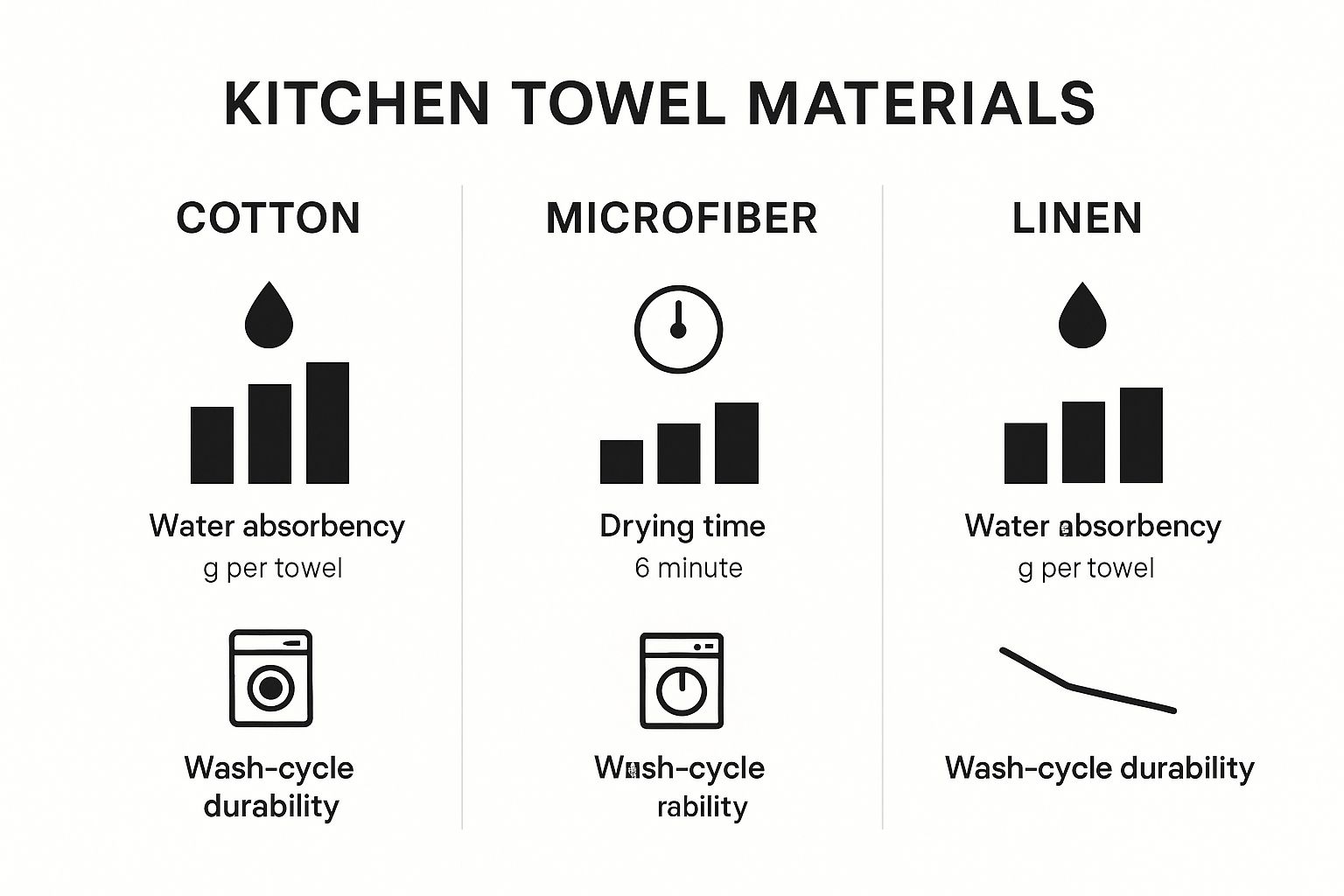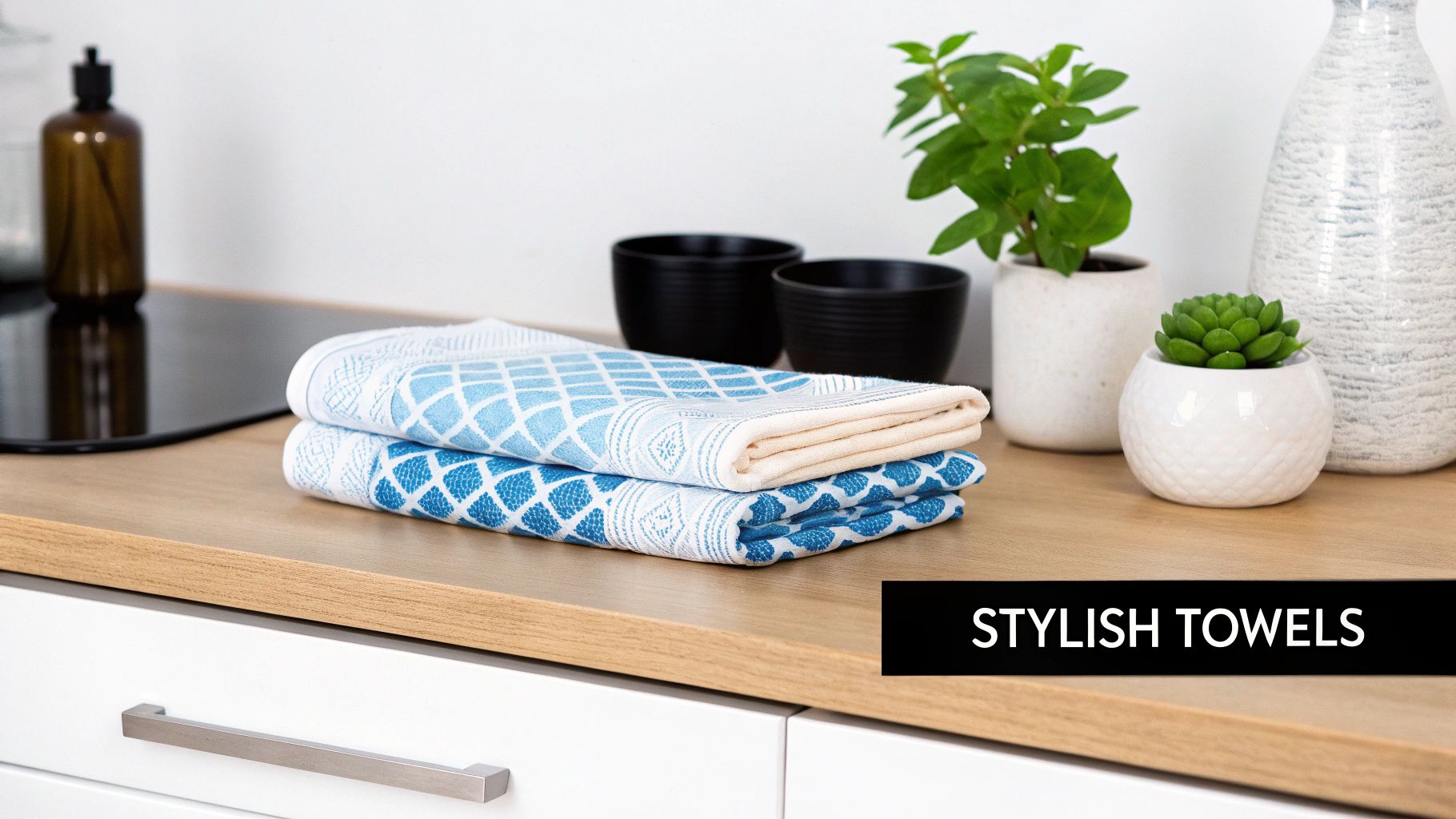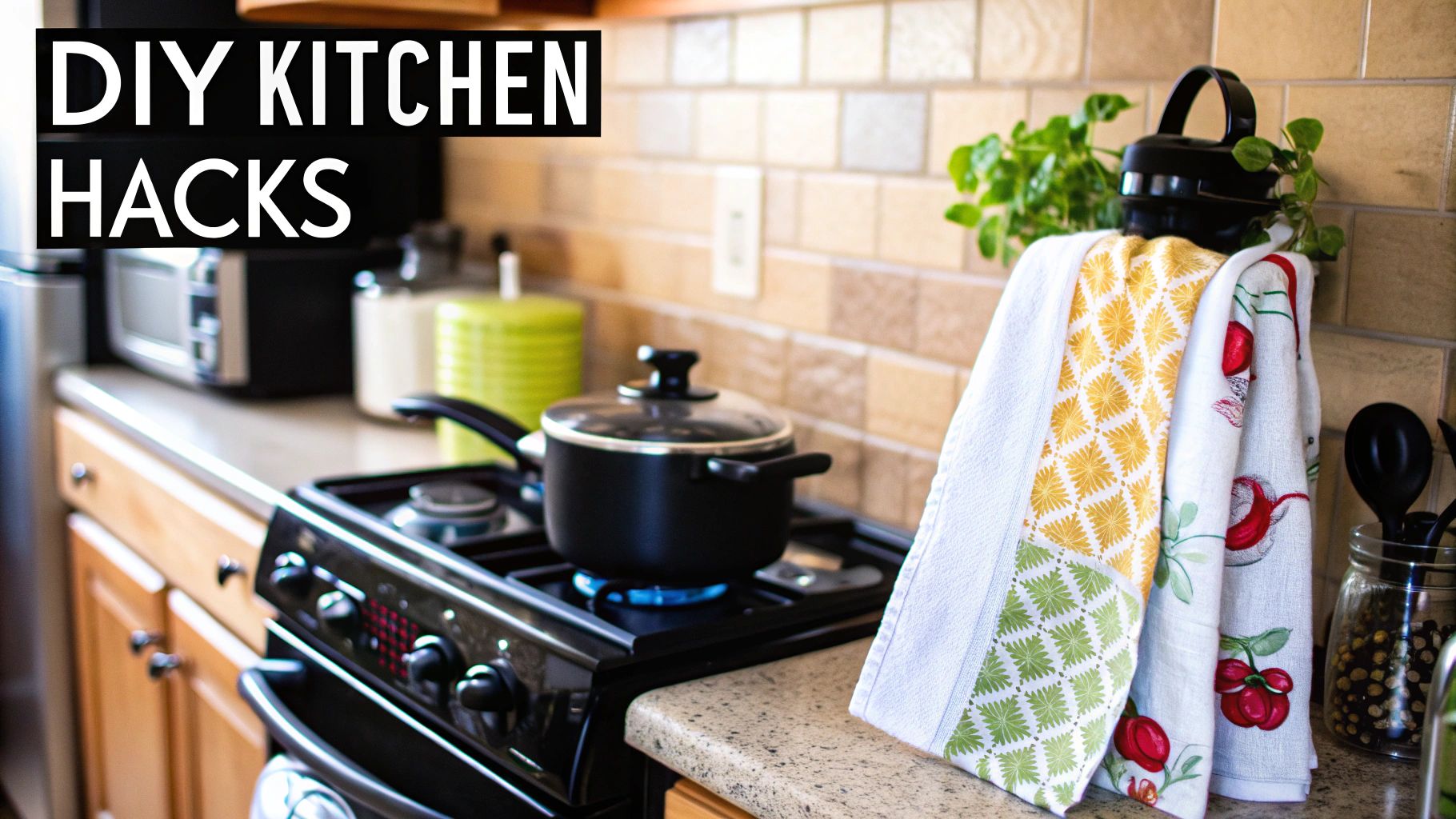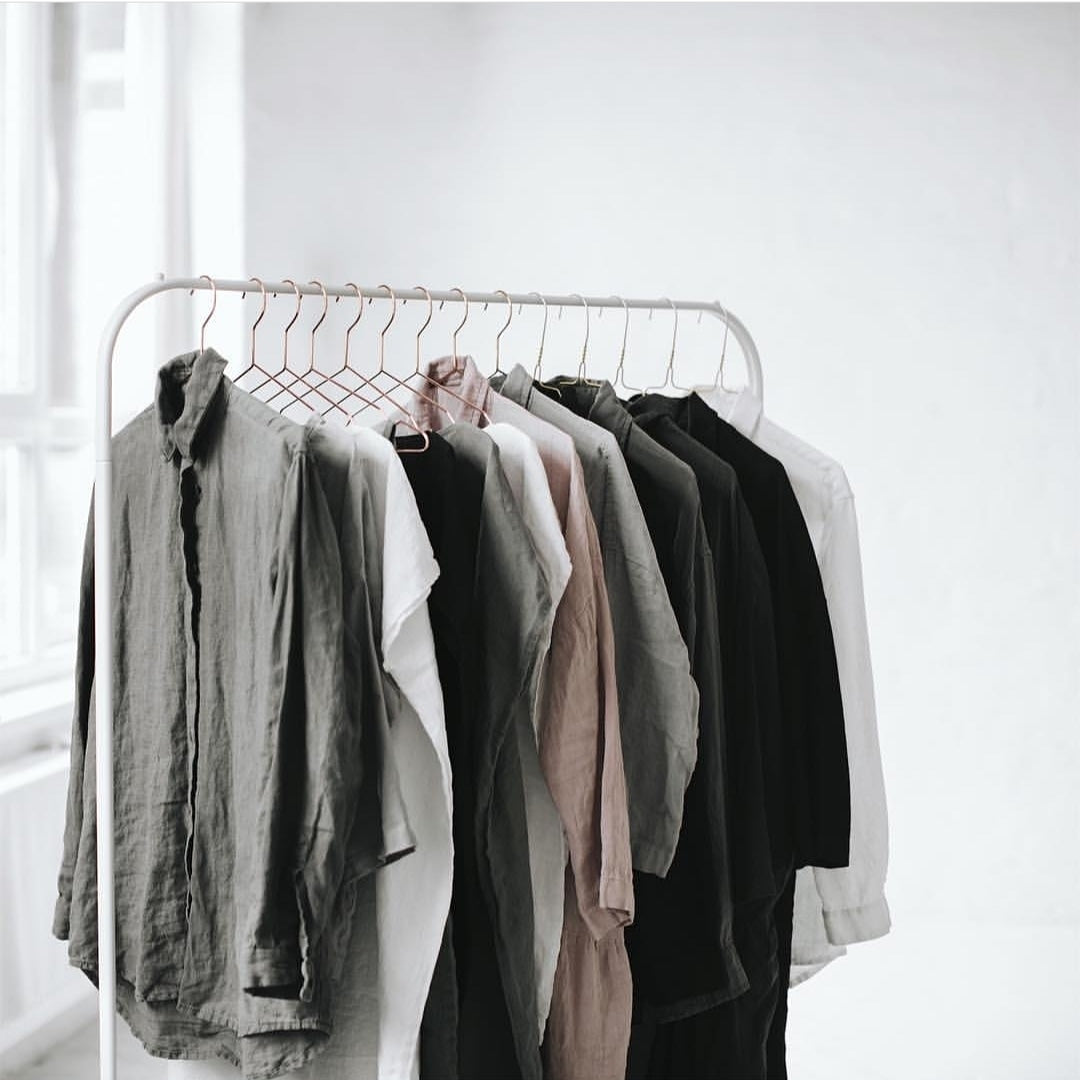The right kitchen towel is one of the most hardworking, versatile tools you can own. It’s far more than just a simple cloth for drying your hands. A good towel can make a real difference to your kitchen's hygiene, your cooking efficiency, and even your safety, making it a surprisingly critical piece of kit.
Why Your Kitchen Towels Are an Essential Tool

Picture a bustling restaurant kitchen for a moment. Chefs have a towel tucked into their apron or slung over their shoulder at all times. They’re not just using it to dry their hands; they’re grabbing hot pan handles, wiping down their stations to keep things clean, and giving plates a final polish before they go out. The home kitchen is really no different.
At its heart, the humble kitchen towel is a genuine multi-tool. From mopping up a sudden spill on the floor to acting as a makeshift pot holder when you’re in a pinch, these simple textiles are indispensable. Their role goes well beyond the obvious, touching on parts of kitchen management you might not have even considered.
More Than Just a Cloth
Choosing the right towel can make your time in the kitchen smoother and safer. A super-absorbent cotton towel, for instance, can soak up a spilled glass of water in seconds, preventing a slippery floor and a potential accident. On the other hand, a crisp, lint-free linen towel is your best friend for getting glassware sparkling and guest-ready, without leaving behind any of those frustrating little fibres.
Just think about all the different hats a single towel can wear:
- Drying Hands and Dishes: This is the most common job, and it calls for great absorbency and a soft touch.
- Handling Hot Cookware: A thick, properly folded towel creates a reliable barrier against heat when you need to move a hot pot or pan off the stove.
- Cleaning Spills and Surfaces: You need durable, hard-wearing towels for wiping down benchtops and tackling everyday messes.
- Polishing and Finishing: Certain lint-free weaves are perfect for giving your cutlery and glasses a professional, streak-free shine.
The New Zealand Demand for Quality
Here in New Zealand, there's a real appreciation for high-quality homewares, and kitchen textiles are certainly no exception. Kiwi households and professional chefs alike want products that look good but are also built to last. This demand has created a very active import market.
Believe it or not, there are currently 38 active kitchen towel importers in New Zealand, bringing in products from 25 different suppliers worldwide. Big names like Kmart and Briscoes are major players, which just goes to show how strong the nationwide need is for quality kitchen towels. If you're curious, you can dig into more data about NZ kitchen towel importers on Volza.com. This bustling market proves just how much Kiwis value this essential kitchen tool.
A great kitchen towel is an investment in efficiency and safety. It’s the unsung hero that supports every culinary creation, from the simplest family meal to the most elaborate dinner party.
Ultimately, seeing your kitchen towels as proper tools—rather than simple accessories—is the first step toward creating a more functional, beautiful, and efficient kitchen. This guide is here to walk you through everything you need to know about choosing, using, and caring for them.
Choosing The Right Kitchen Towel Material
When it comes to outfitting your kitchen, the material of your towels is everything. It's the single biggest factor that determines how well a towel works, how it feels, and how long it will last after countless trips through the wash.
Think of it like picking the right knife for the job. You wouldn't use a delicate paring knife to chop through bone, and you wouldn't use a hefty cleaver for fine detail work. In the same way, understanding the fibres in your kitchen towels helps you build a collection that's not just beautiful, but perfectly functional for every task.
The All-Rounder: Cotton
Cotton is the classic, the go-to, the undisputed workhorse of the kitchen towel world—and for very good reason. It’s naturally absorbent, wonderfully soft, and tough enough for daily use. Because it's such a versatile fibre, you'll find it in a few different forms.
Your standard cotton towel is brilliant for mopping up spills and drying your hands. But if you want to step it up a notch, it’s worth seeking out the premium varieties.
- Egyptian and Pima Cotton: These are the luxury players. Their secret lies in their extra-long fibres, which weave into a towel that's not only incredibly soft but also significantly stronger and more absorbent than standard cotton. They are absolutely perfect for drying delicate dishes without worry.
The Powerhouse: Linen
Linen, derived from the hardy flax plant, is one of the strongest natural fibres you can get. I like to think of linen as the cast-iron pan of kitchen textiles; it can feel a bit stiff at first, but with every single use and wash, it just gets better—softer, more absorbent, and more characterful.
Where linen truly shines is in its lint-free performance. It is the undisputed champion for polishing glassware, cutlery, and windows, leaving behind a sparkling, streak-free finish that other materials just can't match. While it might not feel as thirsty as a thick cotton towel initially, it can absorb a surprising amount of water and, most importantly, it dries incredibly quickly. This rapid drying time is a huge bonus, as it helps prevent that damp, musty smell by stopping bacteria from growing. For a blend of performance and style, you can explore some stunning linen tea towels from NZ designers that truly elevate the everyday.

The Modern Marvel: Microfibre
Microfibre is a bit different. It’s a synthetic material, usually a blend of polyester and polyamide, made from incredibly fine threads. These towels act like powerful magnets for dust, grease, and grime.
All those tiny fibres create a massive surface area, allowing them to trap particles and soak up liquids with impressive efficiency. This makes microfibre fantastic for cleaning and polishing surfaces like stainless steel fridges and granite benchtops, often without needing any chemical sprays. Just a word of caution: microfibre is sensitive to high heat, so never use it to grab a hot pan from the oven!
The Sustainable Choice: Bamboo
For those wanting a more eco-conscious option, bamboo is a fantastic choice. Bamboo is a type of grass that grows incredibly fast, requires very little water, and thrives without pesticides, making it a highly sustainable resource.
The fabric it produces is exceptionally soft, naturally antibacterial, and super absorbent. Bamboo towels feel lovely for drying hands and are gentle enough for wiping fresh produce. That natural antibacterial quality is a real plus, helping them stay fresher for longer in a busy kitchen.
Kitchen Towel Material Comparison
To make it easier to see how these materials stack up, here’s a quick side-by-side comparison.
| Material | Absorbency | Durability | Lint Level | Best For |
|---|---|---|---|---|
| Cotton | High | Good | Medium | General purpose, spills, drying hands |
| Linen | Good | Excellent | Very Low | Polishing glassware, streak-free drying |
| Microfibre | Very High | Good | Low | Cleaning surfaces, trapping dust & grease |
| Bamboo | Very High | Good | Low | Drying hands, eco-friendly option |
Ultimately, there’s no single "best" material. The ideal kitchen is stocked with a team of towels, each with its own speciality. A few cotton towels for spills, a couple of linen ones for glassware, and a microfibre cloth for cleaning gives you a complete toolkit to handle anything your kitchen throws at you.
How Weave Impacts Towel Performance

Now that we've covered the best materials, let's get into another crucial element that dictates how a kitchen towel actually performs: the weave. The way fibres are woven together completely changes a towel's function, turning the same raw material into a tool with a totally different specialty.
Think of it like building with LEGO bricks. You can use the exact same pile of bricks to build a tall, smooth tower or a textured, bumpy wall. The material is identical, but the construction—the weave—creates a wildly different result. This is exactly how the same cotton fibre can become a plush, thirsty towel or a sleek, lint-free polishing cloth.
The Thirsty Classic: Terry Weave
When you think of a classic towel, you're almost certainly picturing a terry weave. This construction is all about its prominent loops of yarn that stand up from the surface, massively increasing its surface area.
These loops act like a tiny forest of sponges, ready to wick moisture away from your hands or countertop. It’s this structure that makes terry cloth so incredibly absorbent and gives it that familiar soft, plush feel.
There is a small trade-off, though. Those same loops that are great for soaking up spills can also snag on cutlery or jewellery. Terry towels are fantastic all-rounders for drying hands and general clean-ups, but they aren't the top pick for jobs needing a perfect, lint-free finish.
The Absorbent Powerhouse: Waffle Weave
You can spot a waffle weave from a mile away thanks to its grid-like pattern of recessed squares, just like the breakfast treat it's named after. This clever design isn't just for show; it's a masterclass in functional engineering.
Those indented pockets act like tiny reservoirs, trapping water and holding a surprising amount of liquid. This makes waffle weave kitchen towels incredibly effective for drying a big load of dishes or mopping up a serious spill.
The unique honeycomb structure also allows air to circulate more freely through the fabric. This means waffle towels dry much faster than dense terry towels—a huge plus in a busy kitchen for keeping musty smells at bay.
After a wash, you'll notice a waffle towel often shrinks up a bit. This actually makes the pockets even deeper and more absorbent. It’s a towel that truly gets better with age, growing softer and more effective over time.
The Polishing Professional: Herringbone Weave
The herringbone weave is known for its distinctive V-shaped pattern, which looks a bit like the skeleton of a herring fish. This diagonal structure creates a fabric that’s both durable and stylish, adding a subtle touch of class to your kitchen.
While still absorbent, herringbone towels are generally thinner and have a smoother surface than their terry or waffle cousins. This makes them a brilliant multi-purpose choice—strong enough for daily drying but gentle enough for more delicate tasks. Their tighter weave also means they produce less lint, making them a solid option for drying dinner plates and cutlery without leaving annoying fibres behind.
The Lint-Free Finisher: Flat Weave
Finally, we have the flat weave. As the name suggests, these towels have a completely smooth, tight surface with no loops or deep texture. Flour sack towels are the perfect example of this category.
This streamlined construction makes them the undisputed champions of lint-free drying. A flat weave is your best friend for polishing delicate wine glasses, shiny cutlery, or even windows to a brilliant, streak-free shine. Because they're so thin, they also dry incredibly fast and fold down compactly for easy storage.
They aren't designed to soak up massive spills, but their utility is immense. They’re also perfect for wrapping warm bread, covering rising dough, or even straining liquids in a pinch. Their performance is closely tied to their density. If you want to dive deeper into how towel weight is measured, you can learn more about what GSM means for towel quality and how it impacts absorbency.
How to Style Your Kitchen with Towels
Kitchen towels are far more than just practical tools for mopping up spills. Think of them as the throw cushions of the kitchen—small, affordable accessories that can completely shift the mood of the room without any major effort. Let's move beyond pure function and explore how you can use these everyday items as a surprisingly powerful part of your kitchen's design.
Whether your space is sleek and modern or has a cosy country vibe, the right towels for kitchen decor can be the finishing touch that ties everything together. It's a fantastic chance to experiment with colour, pattern, and texture without the commitment of a big renovation.
Choosing Your Colour Palette
The best place to start is with your kitchen's existing colour scheme. You have two main paths: either choose towels that blend in for a seamless, harmonious look, or go for a contrasting shade to create an eye-catching statement.
- For a Cohesive Look: Pick out towels in colours that are already present in your cabinetry, benchtops, or splashback. For instance, a kitchen with soft grey cabinets and a white marble benchtop looks incredibly chic with a few charcoal or crisp white linen towels.
- For a Pop of Colour: If your kitchen is a sea of neutrals, towels are your secret weapon for introducing a vibrant accent. A splash of burnt orange, deep navy, or even a soft sage green can bring so much warmth and personality to the space.
A simple change of kitchen towels is one of the easiest ways to update your decor for the seasons. Think warm, earthy tones like rust and mustard for autumn, then switch to bright, fresh pastels like mint or lemon when spring rolls around.
Mastering the Art of Display
It's not just about the towel you choose, but how you display it. A crumpled towel hastily thrown over a handle can make an otherwise tidy kitchen feel messy. In contrast, a neatly styled towel shows a sense of care and intentionality.
Here are a few simple but effective ways to hang your towels:
- The Classic Fold Over: This is the go-to for a reason. Simply fold the towel into thirds lengthwise and drape it evenly over your oven or dishwasher handle. It creates a clean, tidy look that is always in style.
- The Layered Look: Want something a bit more sophisticated? Try layering two different towels. You could drape a patterned towel over a solid-coloured one, or place a textured waffle weave towel behind a smooth linen one. This technique adds depth and makes the styling feel more curated.
- The Hook or Ring: Installing a small, stylish hook or ring near your sink gives you a dedicated spot for your hand-drying towel. It keeps it handy, separates it from towels used for dishes, and adds a nice decorative element.
Adding a Personalised Touch
For a kitchen that feels truly yours, why not customise your towels? A simple personal detail can transform a standard towel into a bespoke piece that reflects your personality or makes for a wonderful, thoughtful gift.
You could even try a new craft like hand embroidery. A simple monogram or a small, delicate pattern can instantly elevate your kitchen linens. If you're just starting out, there are plenty of easy guides that teach you how to embroider a name by hand.
Styling with towels is one of the most budget-friendly ways to keep your kitchen looking fresh and inviting. By carefully choosing colours, playing with patterns, and thinking about your display, you can turn these functional workhorses into beautiful accessories that complete your kitchen's look.
Keeping Your Kitchen Towels Fresh and Clean

Choosing high-quality towels for kitchen duties is a great start, but how you care for them is what really makes them last. Proper maintenance keeps your towels absorbent, soft, and free from that musty smell that can take over a busy kitchen. With just a few simple habits, you can keep your kitchen linens looking and feeling great for years.
Think of your towels like any other essential kitchen tool. You wouldn't let your best knife get dull and rusty, would you? Your towels need the same kind of regular, correct care to do their job properly. It's about more than just chucking them in the wash—it’s knowing how to clean, dry, and store them to protect the fibres.
The Crucial First Wash
Believe it or not, the most important wash a new kitchen towel will ever get is its very first one. Towels straight from the shop are often coated with a layer of silicone or fabric softener to make them feel irresistibly soft on the shelf. The catch? This coating actually repels water, which is the last thing you want in a towel.
To unlock your towel's true thirst, you need to strip that factory finish away.
- Wash Them Solo: Pop your new towels in for a wash on their own. This prevents any sneaky dye from bleeding onto your other laundry.
- Go for Warm Water: A warm cycle is perfect for dissolving those initial coatings.
- Add White Vinegar: Pour one cup of white vinegar into the rinse cycle. Vinegar is fantastic for breaking down that waxy residue without being harsh on the fabric.
- Skip the Detergent (Just This Once): For the first wash, vinegar is all you need to do the trick.
Taking this one simple step before you use them will make a massive difference to their absorbency, getting them ready for action.
Best Practices for Routine Washing
Once your towels are part of the daily grind, a solid washing routine is key to keeping them hygienic and effective. A damp, used kitchen towel is a paradise for bacteria, so washing them often is a must.
As a rule of thumb, a towel used for wiping down benchtops or drying hands should be swapped out daily. If it's only used for drying clean dishes, it might last two or three days. When in doubt, it’s always better to wash it.
For the best results, give your towels their own load. Washing them with clothes can lead to lint getting everywhere, and zips or buttons can easily snag the fabric. And whatever you do, steer clear of fabric softener! It builds up a coating on the fibres that slowly but surely ruins their ability to soak up moisture.
If your towels start to feel a bit stiff or get a bit smelly, adding a cup of vinegar to the rinse cycle every few washes will work wonders to soften them up and get rid of odours. For more in-depth advice on fabric care, our comprehensive linen care guide is a great resource for all your quality textiles.
Tackling Stubborn Kitchen Stains
Let's face it, kitchen towels see it all—from coffee spills and red wine drips to splatters of grease. The secret to getting stains out is to act fast.
- Grease and Oil: Before you wash it, dab a bit of dish soap directly onto the spot. Gently rub it in to break down the oil, then wash as normal.
- Coffee, Tea, or Wine: Immediately blot the stain with a clean, damp cloth—don't rub it in! Then, you can soak the towel for 30 minutes in cool water with a little laundry detergent before it goes into the machine.
- Tomato-Based Stains: The trick here is to rinse the stain from the back of the fabric with cold water. This helps push the stain out instead of deeper in. Pretreat it with a stain remover or a simple paste of baking soda and water before washing.
A little bit of proper care goes a long way. It’s what transforms your kitchen towels from something disposable into hardworking, long-lasting essentials for your home.
Making Sustainable Kitchen Towel Choices
As we all become more aware of our environmental impact, every little choice we make at home feels more significant. This is especially true in the kitchen, which is often the heart of the home and a hub of activity. Choosing sustainable towels for kitchen use is a small but surprisingly powerful way to shrink your footprint and align your daily routines with a desire to look after our beautiful New Zealand environment.
This move toward greener products isn't just a fleeting trend; it's a major shift happening worldwide. The kitchen towel market is expected to jump from USD 2.49 billion to USD 3.23 billion by 2029, and a big reason for that growth is the demand for sustainable materials. As people focus more on health and the environment, they're actively looking for products that are better for their families and the planet. You can dive deeper into these global kitchen textile market trends to see how our choices here in NZ fit into the global picture.
Choosing Planet-Friendly Fibres
The first stop on the road to sustainability is the fabric itself. Luckily, there are some brilliant options out there that work beautifully without the environmental baggage.
- Organic Cotton: This is cotton grown the old-fashioned way—without synthetic pesticides or fertilisers. That makes it much kinder to the soil, waterways, and the farmers who grow it. You still get all the wonderful softness and absorbency of conventional cotton, just with a much clearer conscience.
- Bamboo: Bamboo is one of the fastest-growing plants on earth, making it an incredibly renewable resource. It needs very little water and no pesticides to grow, producing a fabric that’s naturally antibacterial, ridiculously soft, and a great little workhorse for soaking up spills.
- Recycled Fibres: Clever new textiles are now being made from recycled materials, like post-consumer plastics or even off-cuts from cotton manufacturing. These towels give waste a second life and keep it out of our landfills, all while reducing the need to create new materials from scratch.
Thinking about where our products come from can really change our perspective. It’s similar to how understanding the ethical sourcing practices for coffee can help you create a kitchen that’s sustainable from your morning brew to your evening clean-up.
Durability: The Ultimate Form of Sustainability
While picking the right material is a great start, one of the most eco-friendly things you can do is simply buy less. This is where the old "buy once, buy well" adage really rings true. A top-quality, durable kitchen towel might cost a bit more upfront, but it will easily outlast a whole stack of its cheaper, flimsier counterparts.
Investing in a well-made linen or premium cotton towel means you are creating less waste over time. It’s a shift from a disposable mindset to one that values longevity and craftsmanship.
Think about it. Every time a cheap towel rips, frays, or loses its absorbency, it gets tossed out and heads to the landfill. By choosing a towel that’s built to withstand years of wiping, drying, and washing, you’re actively cutting down on that waste. This makes durability a cornerstone of a truly sustainable kitchen, proving that quality isn’t just a luxury—it’s a smart, practical choice for the planet.
Got Questions About Kitchen Towels? We’ve Got Answers.
Even after you’ve picked the perfect material and weave, a few practical questions always seem to pop up. When it comes to the daily grind, how do you get the most out of your kitchen towels? Let’s tackle some of the most common queries with clear, straightforward answers.
Think of this as your quick-reference guide for solving those little kitchen towel mysteries and building better habits for a cleaner, more efficient space.
How Many Kitchen Towels Do I Really Need?
I always recommend having a solid rotation of about 10 to 12 kitchen towels on hand. That number might sound like a lot, but it means you’ll always have a fresh, clean towel ready to go while the others are in the wash. No more getting caught short!
It helps to think of it like building a small, specialised team for your kitchen. A great setup would include:
- 3-4 highly absorbent towels: These are your go-to for drying dishes and hands.
- 3-4 durable utility towels: Your workhorses. Use these for wiping spills and cleaning benchtops.
- 2-3 lint-free towels: Keep these aside just for polishing glassware and cutlery to a perfect, streak-free shine.
With a system like this, you’re always using the right tool for the job.
Why Are My New Towels Not Soaking Up Water?
This is a classic problem, and thankfully, the fix is simple. New towels often leave the factory with a special coating—usually a type of fabric softener—that gives them that lovely soft feel in the store. The downside? This coating actively repels water.
To unlock their true absorbency, you just need to wash them before their first use. A warm wash with a little detergent, plus a cup of white vinegar in the rinse cycle, will work wonders to strip away that residue. A crucial tip: avoid using fabric softener on your towels for kitchen jobs from now on, as it will just re-coat the fibres and hinder their ability to soak up moisture.
For hygiene’s sake, it’s always best practice to use separate towels for drying hands and dishes to avoid cross-contamination. A simple colour-coding system works beautifully—maybe patterned towels for dishes and plain ones for hands? It’s an easy habit to get into, even in the busiest of kitchens.
How Often Should I Be Washing My Kitchen Towels?
Kitchen towels live in a damp environment, which is a breeding ground for bacteria, so they need to be washed often. Exactly how often really depends on what you’re using them for.
A towel used just for drying freshly cleaned dishes can probably be used two or three times before it needs a wash. On the other hand, a towel you use for wiping your hands or cleaning benchtops should be swapped out for a fresh one every single day. And if a towel gets soaked from a big spill, don't hesitate—change it out immediately.
At The Foxes Den, we believe that even the hardest-working items in your home should be beautiful and built to last. We’ve curated a collection of premium linen and cotton kitchen towels, designed to bring timeless style and exceptional performance to your daily rituals. Discover the perfect addition to your kitchen at The Foxes Den.


